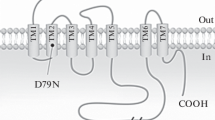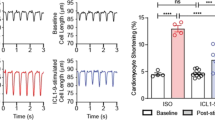Abstract
Purpose
Relaxin, a new drug for heart failure therapy, exerts its cardiac actions through relaxin family peptide receptor 1 (RXFP1). Factors regulating RXFP1 expression remain unknown. We have investigated effects of activation of adrenoceptors (AR), an important modulator in the development and prognosis of heart failure, on expression of RXFP1 in rat cardiomyocytes and mouse left ventricles (LV).
Methods
Expression of RXFP1 at mRNA (real-time PCR) and protein levels (immunoblotting) was measured in cardiomyocytes treated with α- and β-AR agonists or antagonists. RXFP1 expression was also determined in the LV of transgenic mouse strains with cardiac-restricted overexpression of α1A-, α1B- or β2-AR. Specific inhibitors were used to explore signal pathways involved in α1-AR mediated regulation of RXFP1 in cardiomyocytes.
Results
In cultured cardiomyocytes, α1-AR stimulation resulted in 2–3 fold increase in RXFP1 mRNA (P < 0.001), which was blocked by specific inhibitors for protein kinase C (PKC) or mitogen-activated protein kinases/extracellular signal-regulated kinases (MAPK/ERK). Activation of β1-, but not β2-AR, significantly inhibited RXFP1 expression (P < 0.001). Relative to respective wild-type controls, RXFP1 mRNA levels in the LV of mice overexpressing α1A- or α1B-AR were increased by 3- or 10-fold, respectively, but unchanged in β2-AR transgenic hearts. Upregulation by α1-AR stimulation RXFP1 expression was confirmed at protein levels both in vitro and in vivo.
Conclusions
Expression of RXFP1 was up-regulated by α1-AR but suppressed by β-AR, mainly β1-AR subtype, in cardiomyocytes. Future studies are warranted to characterize the functional significance of such regulation, especially in the setting of heart failure.




Similar content being viewed by others
References
Du XJ, Bathgate RA, Samuel CS, Dart AM, Summers RJ. Cardiovascular effects of relaxin: from basic science to clinical therapy. Nat Rev Cardiol. 2010;7:48–58.
Conrad KP. Unveiling the vasodilatory actions and mechanisms of relaxin. Hypertension. 2010;56:2–9.
Grossman J, Frishman WH. Relaxin: a new approach for the treatment of acute congestive heart failure. Cardiol Rev. 2010;18:305–12.
Zhang J, Qi YF, Geng B, et al. Effect of relaxin on myocardial ischemia injury induced by isoproterenol. Peptides. 2005;26:1632–9.
Perna AM, Masini E, Nistri S, et al. Novel drug development opportunity for relaxin in acute myocardial infarction: evidences from a swine model. FASEB J. 2005;19:1525–7.
Moore XL, Tan SL, Lo CY, et al. Relaxin antagonizes hypertrophy and apoptosis in neonatal rat cardiomyocytes. Endocrinology. 2007;148:1582–9.
Dschietzig T, Bartsch C, Kinkel T, et al. Myocardial relaxin counteracts hypertrophy in hypertensive rats. Ann N Y Acad Sci. 2005;1041:441–3.
Teerlink JR, Cotter G, Davison BA, et al. Serelaxin, recombinant human relaxin-2, for treatment of acute heart failure (RELAX-AHF): a randomised, placebo-controlled trial. Lancet. 2013;381:29–39.
Hernandez-Montfort JA, Arora S, Slawsky MT. Relaxin for treatment of acute heart failure: making the case for treating targeted patient profiles. Curr Heart Fail Rep. 2013;10:198–203.
Hsu SY, Nakabayashi K, Nishi S, et al. Activation of orphan receptors by the hormone relaxin. Science. 2002;295:671–4.
Bathgate RA, Halls ML, van der Westhuizen ET, Callander GE, Kocan M, Summers RJ. Relaxin family peptides and their receptors. Physiol Rev. 2013;93:405–80.
Osheroff PL, King KL. Binding and cross-linking of 32P-labeled human relaxin to human uterine cells and primary rat atrial cardiomyocytes. Endocrinology. 1995;136:4377–81.
Samuel CS, Unemori EN, Mookerjee I, et al. Relaxin modulates cardiac fibroblast proliferation, differentiation, and collagen production and reverses cardiac fibrosis in vivo. Endocrinology. 2004;145:4125–33.
Cohn JN, Levine TB, Olivari MT, et al. Plasma norepinephrine as a guide to prognosis in patients with chronic congestive heart failure. N Engl J Med. 1984;311:819–23.
Chatterjee S, Biondi-Zoccai G, Abbate A, et al. Benefits of beta blockers in patients with heart failure and reduced ejection fraction: network meta-analysis. BMJ. 2013;346:f55.
Jensen BC, O’Connell TD, Simpson PC. α1-adrenergic receptors: targets for agonist drugs to treat heart failure. J Mol Cell Cardiol. 2011;51:518–28.
Woodcock EA, Du XJ, Reichelt ME, et al. Cardiac α1-adrenergic drive in pathological remodelling. Cardiovasc Res. 2008;77:452–62.
Moore XL, Hong A, Du XJ. α-adrenergic activation upregulates expression of relaxin receptor RXFP1 in cardiomyocytes. Ann N Y Acad Sci. 2009;1160:285–6.
Lin F, Owens WA, Chen S, et al. Targeted α1A-adrenergic receptor overexpression induces enhanced cardiac contractility but not hypertrophy. Circ Res. 2001;89:343–50.
Milano CA, Dolber PC, Rockman HA, et al. Myocardial expression of a constitutively active α1B-adrenergic receptor in transgenic mice induces cardiac hypertrophy. Proc Natl Acad Sci U S A. 1994;91:10109–13.
Milano CA, Allen LF, Rockman HA, et al. Enhanced myocardial function in transgenic mice overexpressing the β2-adrenergic receptor. Science. 1994;264:582–6.
Liu Y, Gao XM, Fang L, et al. Novel role of platelets in mediating inflammatory responses and ventricular rupture or remodeling following myocardial infarction. Arterioscler Thromb Vasc Biol. 2011;31:834–41.
Osheroff PL, Cronin MJ, Lofgren JA. Relaxin binding in the rat heart atrium. Proc Natl Acad Sci U S A. 1992;89:2384–8.
Scott DJ, Layfield S, Riesewijk A, Morita H, Tregear GW, Bathgate RA. Characterization of the mouse and rat relaxin receptors. Ann N Y Acad Sci. 2005;1041:8–12.
Yan W, Chen J, Wiley AA, Crean-Harris BD, Bartol FF, Bagnell CA. Relaxin (RLX) and estrogen affect estrogen receptor alpha, vascular endothelial growth factor, and RLX receptor expression in the neonatal porcine uterus and cervix. Reproduction. 2008;135:705–12.
Vodstrcil LA, Shynlova O, Westcott K, et al. Progesterone withdrawal, and not increased circulating relaxin, mediates the decrease in myometrial relaxin receptor (RXFP1) expression in late gestation in rats. Biol Reprod. 2010;83:825–32.
Noma T, Lemaire A, Nega Prasad SV, et al. Beta-arrestin-mediated beta1-adrenergic receptor transactivation of the EGFR confers cardioprotection. J Clin Invest. 2007;117:2445–58.
Pereira L, Cheng H, Lao DH, et al. Epac2 mediates cardiac beta1-adrenergic-dependent sarcoplasmic reticulum Ca2+ leak and arrhythmia. Circulation. 2013;127:913–22.
Gong K, Li Z, Xu M, Du J, Lu Z, Zhang Y. A novel protein kinase A-independent, beta-arrestin-1-dependent signaling pathway for p38 mitogen-activated protein kinase activation by beta2-adrenergic receptors. J Biol Chem. 2008;283:29028–36.
Noor N, Patel CB, Rockman HA. Beta-arrestin: a signaling molecule and potential therapeutic target for heart failure. J Mol Cell Cardiol. 2011;51:534–41.
Xu Q, Dalic A, Fang L, et al. Myocardial oxidative stress contributes to transgenic beta-adrenoceptor activation-induced cardiomyopathy and heart failure. Br J Pharmacol. 2011;162:1012–28.
Kompa AR, Samuel CS, Summers RJ. Inotropic responses to human gene 2 (B29) relaxin in a rat model of myocardial infarction (MI): effect of pertussis toxin. Br J Pharmacol. 2002;137:710–8.
Dschietzig T, Alexiou K, Kinkel HT, Baumann G, Matschke K, Stangl K. The positive inotropic effect of relaxin-2 in human atrial myocardium is preserved in end-stage heart failure: role of G(i)-phosphoinositide-3 kinase signaling. J Card Fail. 2011;17:158–66.
Parikh A, Patel D, McTiernan CF, et al. Relaxin suppresses atrial fibrillation by reversing fibrosis and myocyte hypertrophy and increasing conduction velocity and sodium current in spontaneously hypertensive rat hearts. Circ Res. 2013;113:313–21.
Samuel CS, Du XJ, Bathgate RA, Summers RJ. ‘Relaxin’ the stiffened heart and arteries: the therapeutic potential for relaxin in the treatment of cardiovascular disease. Pharmacol Ther. 2006;112:529–52.
Xu Q, Chakravorty A, Bathgate RA, Dart AM, Du XJ. Relaxin therapy reverses large artery remodeling and improves arterial compliance in senescent spontaneously hypertensive rats. Hypertension. 2010;55:1260–6.
Dschietzig T, Teichman S, Unemori E, et al. Intravenous recombinant human relaxin in compensated heart failure: a safety, tolerability, and pharmacodynamic trial. J Card Fail. 2009;15:182–90.
Francis GS, McDonald KM, Cohn JN. Neurohumoral activation in preclinical heart failure. Remodeling and the potential for intervention. Circulation. 1993;87:IV90–6.
Kaye DM, Lambert GW, Lefkovits J, Morris M, Jennings G, Esler M. Neurochemical evidence of cardiac sympathetic activation and increased central nervous system norepinephrine turnover in severe congestive heart failure. J Am Coll Cardiol. 1994;23:570–8.
Metra M, Ponikowski P, Cotter G, et al. Effects of serelaxin in subgroups of patients with acute heart failure: results from RELAX-AHF. Eur Heart J. 2013;34:3128–36.
Acknowledgments
This work was funded by project grants from the National Health and Medical Research Council (NHMRC) (1004235 and 1005329 to XJD), the Victorian Government’s Operational Infrastructure Program and Nature Science Fund of China (30910103902 to YYZ and XJD). EAW, AMD and XJD are NHMRC research fellows.
Disclosure Statement
All authors have nothing to declare.
Author information
Authors and Affiliations
Corresponding author
Rights and permissions
About this article
Cite this article
Moore, XL., Su, Y., Fan, Y. et al. Diverse Regulation of Cardiac Expression of Relaxin Receptor by α1- and β1-Adrenoceptors. Cardiovasc Drugs Ther 28, 221–228 (2014). https://doi.org/10.1007/s10557-014-6525-x
Published:
Issue Date:
DOI: https://doi.org/10.1007/s10557-014-6525-x




